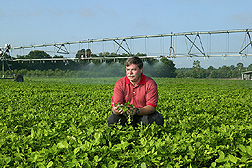This page has been archived and is being provided for reference purposes only. The page is no longer being updated, and therefore, links on the page may be invalid.
Read the magazine story to find out more. |
|
ARS Scientists Collaborate to Increase Irrigation Accuracy
By Laura McGinnisOctober 7, 2005
Agricultural Research Service (ARS) laboratories in South Carolina, Montana and Colorado are combining traditional equipment and cutting-edge tools in a system that provides just the right amount of irrigation.
Researchers at the ARS Coastal Plains Soil, Water and Plant Research Center at Florence, S.C., are assessing variables such as soil quality, crop type and temperature to determine when and where to irrigate. Through several years of testing, scientists have modified their center-pivot systems to distribute water more accurately.
Scheduling irrigations to meet crop demands is a challenge, but sprinkler systems are being developed to meet it. Current research is investigating the benefits of variable-rate irrigation.
Frequently, soil, topography and water needs vary within a field. For instance, a 14-acre field in Florence could have 12 different soil types. Precision irrigation, according to ARS agricultural engineer Kenneth Stone at Florence, aims to match water application with soil variations and crops. More precise delivery of water, nutrients and pesticides means higher yields and environmental benefits.
Excessive watering, a chronic pitfall, can leach chemicals into groundwater. Wet plant leaves are more vulnerable to disease from moisture-loving fungi, increasing the need for fungicides.
In Sidney, Mont., Robert Evans, an agricultural engineer at the ARS Northern Plains Agricultural Research Laboratory, investigates how GPS, wireless communications and real-time microclimate and soils monitoring will allow traditional irrigation equipment to deliver water and nutrients across varying landscapes with greater precision.
Dale F. Heermann, a collaborator at the ARS Water Management Research Unit in Fort Collins, Colo., and his colleagues developed a computer program called Center Pivot Evaluation and Design that models water distribution and predicts irrigation uniformity. Heermann's group has also developed technology allowing farmers to reduce herbicide use without yield losses.
ARS researchers strive to improve efficiency and environmental consequences of traditional irrigation techniques. Great progress has been made, but Evans believes the best is yet to come.
Read more about the research in the October 2005 issue of Agricultural Research magazine.
ARS is the U.S. Department of Agriculture’s chief in-house scientific research agency.


